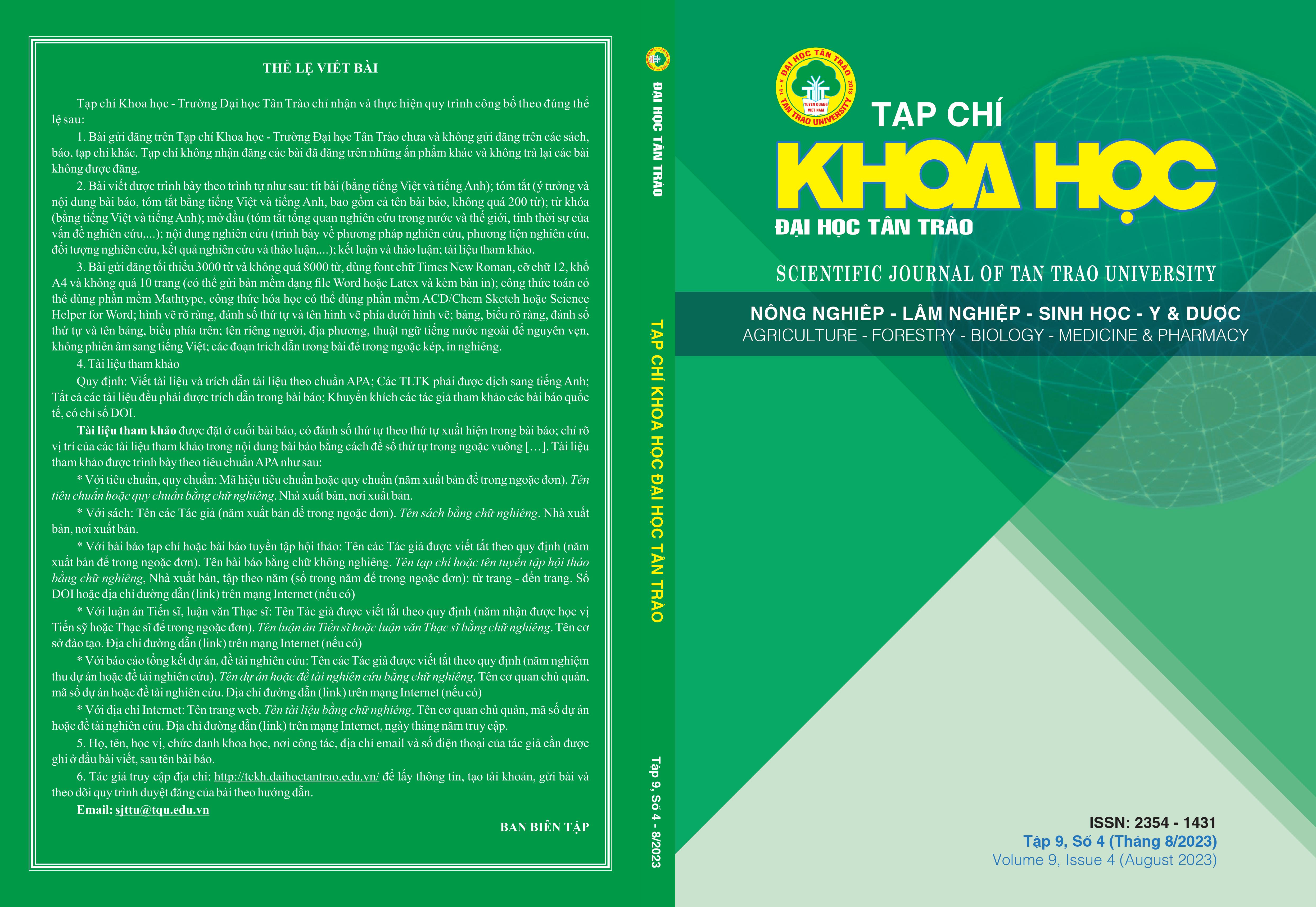NGHIÊN CỨU THÀNH PHẦN LOÀI ĐỘNG VẬT ĐÁY TRONG RỪNG NGẬP MẶN VÀ HIỆN TRẠNG THẢM CỎ BIỂN TRONG HỆ SINH THÁI VEN BIỂN, TỈNH TIỀN GIANG
DOI:
https://doi.org/10.51453/2354-1431/2023/999Tóm tắt
Nghiên cứu về thành phần loài động vật đáy và cỏ biển tại huyện Gò Công Đông (Tiền Giang). Nằm trong khuôn khổ dự án “Điều tra, đánh giá hiện trạng nhận chìm và xác định các khu vực có thể nhận chìm tại vùng biển từ mực nước triều thấp nhất trung bình nhiều năm ra phía biển 12 hải lý”, được tiến hành vào 12/2022. Thành phần động vật đáy rừng ngập mặn ven biển Tiền Giang đã phát hiện 62 loài thuộc 36 họ và 5 nhóm đại diện. Khối lượng trung bình của tất cả các loài W = 106,08 g/m2; Mật độ trung bình của tất cả các loài là V = 58,2 cá thể/m2; Chỉ số đa dạng ở mức độ thấp H’ = 1,88. Kết quả xác đinh tại các trạm thu mẫu cho thấy cỏ biển không xuất hiện ở khu vực ven biển Tiền Giang. Qua nghiên cứu và tổng hợp nhóm đã đề xuất, đưa ra tiêu chí về khoảng cách và các chỉ số đa dạng đối với sự sinh trưởng phát triển của nhóm quần động vật đáy và hệ sinh thái cỏ biển đối với quá trình nhận chìm vật, chất xuống biển.
Tải xuống
Tài liệu tham khảo
[1] Duong, P. T., Son, T. (2021), Assessment of changes in mangrove forests in Tien Giang province on the basis of satellite images for the period 1988-2018. Scientific Journal of Can Tho University. Vol 57, No. 1A. P 64-74.
[2] Hoi N. C. (2012), Investing in Coastal Ecosystems, A Journalist's Guide to the Role of Coastal Ecosystems. Mangroves for the future. Gland, Switzerland: IUCN. 27 pages.
[3] Duong T. T., Vinh C. T., Tuan T. M., Dang N. Q. (2001), Some common fish species in the sea of Vietnam, Ministry of Fisheries. Ha Noi. P 195
[4] Nhuong D. V., Khac H. N. (2006), Preliminary data on crabs (Brachyura) in coastal mangroves from Tinh Gia (Thanh Hoa) to Hoi An (Quang Nam), Journal of Biology. Volum 28(1), P 35-39.
[5] Tien, N.V. (2013), Resources of Vietnam's seagrass beds. Natural Science and Technology Publishing House. P. 346.
[6] Arthur Anker and Ivan N. Martin (2000), New records and species of Alpheidae (Crustacea: Decapoda) from Vietnam. Part I. Genus Salmoneus Holthuis,1955. Atlantic Volum 54, P 295-319.
[7] Blakemore R. J. (2007), Origin and means of disperal of cosmopolitan Pontodrilus litralis (Oligochaeta: Megascolecidae). European journal of Soil Biology, 43, P. S3-S8.
[8] Dai Ai-yun and Yang Si Liang (1991), Crabs of the China seas. China Ocean Press Beijing. p. 118-558.
[9] Han Raven, Jaap Jan Vermeulen (2006), Notes on molluscs from NW Borneo and Singapore. 2. A synopsis of the Ellobiidae (Gastropoda, Pulmonata, Vita Malacologica 4: P 29-62.
[10] Jocelyn Crane (1975), Fiddler crabs of the World. P 15-327.
[11] Kent E. Carpenter and Volker H. Niem (1998), The living marine resources of the Western Central Pacific.FAO. Rome. Volum 1. P 124-646.
[12] Nora F. Y. Tam and Y. S. Wong (2000), Hong Kong mangroves, City University of Hong Kong press. P 148.
[13] Shannon C. E. and Weiner W. (1963), The mathematical theory of communities. Illinois Urbana University, IllinoisPress
Tải xuống
Đã Xuất bản
Cách trích dẫn
Số
Chuyên mục
Giấy phép

Tác phẩm này được cấp phép theo Giấy phép Quốc tế Creative Commons Attribution-ShareAlike 4.0 .
Bài báo được xuất bản ở Tạp chí Khoa học Đại học Tân Trào được cấp phép theo giấy phép Ghi công - Chia sẻ tương tự 4.0 Quốc tế (CC BY-SA). Theo đó, các tác giả khác có thể sao chép, chuyển đổi hay phân phối lại các bài báo này với mục đích hợp pháp trên mọi phương tiện, với điều kiện họ trích dẫn tác giả, Tạp chí Khoa học Đại học Tân Trào và đường link đến bản quyền; nêu rõ các thay đổi đã thực hiện và các nghiên cứu đăng lại được tiến hành theo cùng một bản quyền.
Bản quyền bài báo thuộc về các tác giả, không hạn chế số lượng. Tạp chí Khoa học Tân Trào được cấp giấy phép không độc quyền để xuất bản bài báo với tư cách nhà xuất bản nguồn, kèm theo quyền thương mại để in các bài báo cung cấp cho các thư viện và cá nhân.
Mặc dù các điều khoản của giấy phép CC BY-SA không dành cho các tác giả (với tư cách là người giữ bản quyền của bài báo, họ không bị hạn chế về quyền hạn), khi gửi bài tới Tạp chí Khoa học Đại học Tân Trào, tác giả cần đáp ứng quyền của độc giả, và cần cấp quyền cho bên thứ 3 sử dụng bài báo của họ trong phạm vi của giấy phép.






